Conceptual Design in Systems Engineering: Analysis of Bridge Design
VerifiedAdded on 2024/06/27
|15
|2873
|391
Report
AI Summary
This report provides an analysis of conceptual design within a systems engineering project, focusing on bridge design and the construction of environmentally-conscious, shockproof buildings. It examines requirements in the designing phase, including interface management, functional analysis, and physical design allocation. The report discusses preliminary design, detailed design, system testing, evaluation, validation, and optimization processes, with specific attention to materials like shape memory alloys, elastomeric bearings, and base isolation techniques used in shockproof construction. The analysis includes components of the Golden Gate Bridge and explores the feasibility, technical aspects, economic considerations, and operational requirements for building resilient structures. The report emphasizes the iterative nature of system development, the importance of validation against customer requirements, and the optimization process for mitigating risks and ensuring financial viability, highlighting the role of the systems engineer in balancing cost, risk, and performance throughout the project lifecycle.
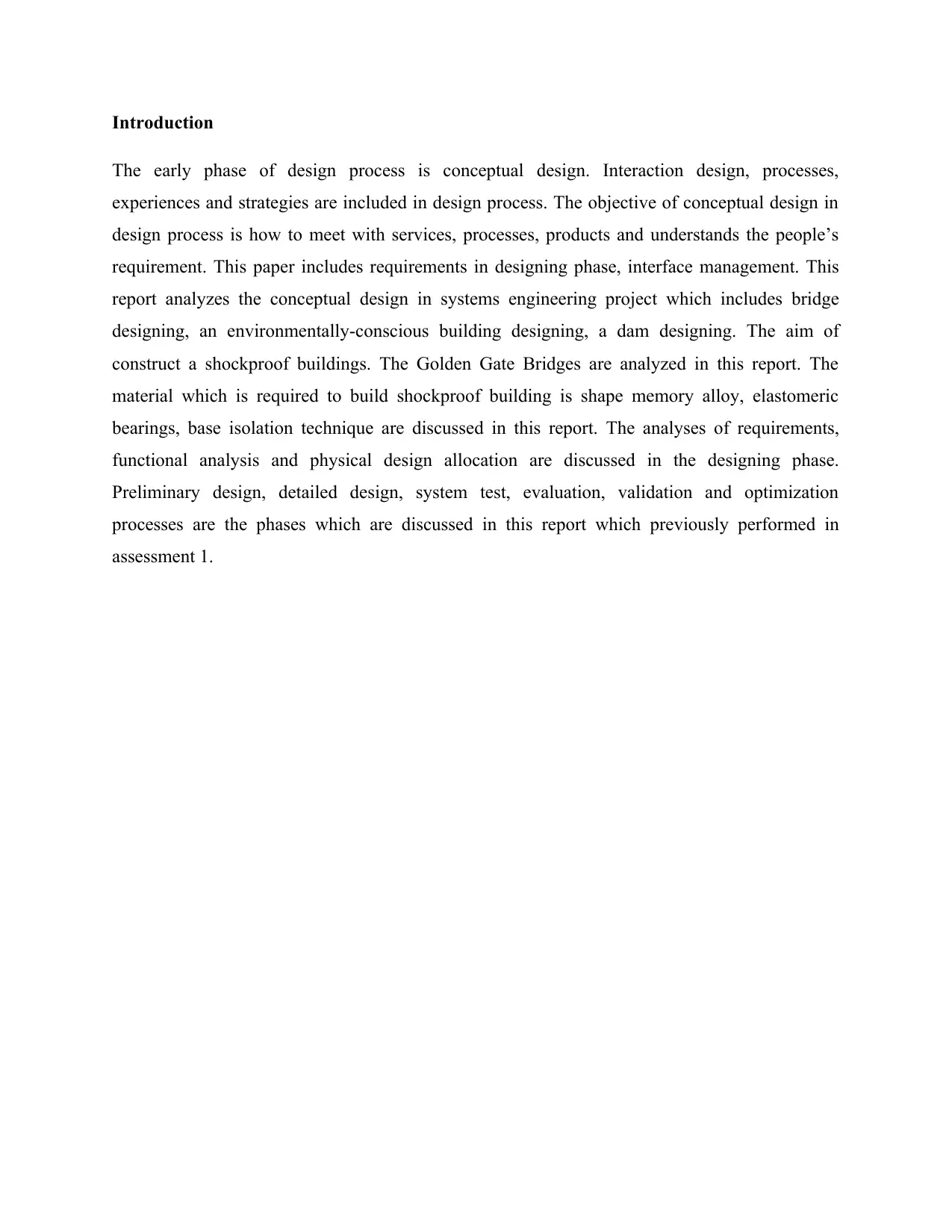
Introduction
The early phase of design process is conceptual design. Interaction design, processes,
experiences and strategies are included in design process. The objective of conceptual design in
design process is how to meet with services, processes, products and understands the people’s
requirement. This paper includes requirements in designing phase, interface management. This
report analyzes the conceptual design in systems engineering project which includes bridge
designing, an environmentally-conscious building designing, a dam designing. The aim of
construct a shockproof buildings. The Golden Gate Bridges are analyzed in this report. The
material which is required to build shockproof building is shape memory alloy, elastomeric
bearings, base isolation technique are discussed in this report. The analyses of requirements,
functional analysis and physical design allocation are discussed in the designing phase.
Preliminary design, detailed design, system test, evaluation, validation and optimization
processes are the phases which are discussed in this report which previously performed in
assessment 1.
The early phase of design process is conceptual design. Interaction design, processes,
experiences and strategies are included in design process. The objective of conceptual design in
design process is how to meet with services, processes, products and understands the people’s
requirement. This paper includes requirements in designing phase, interface management. This
report analyzes the conceptual design in systems engineering project which includes bridge
designing, an environmentally-conscious building designing, a dam designing. The aim of
construct a shockproof buildings. The Golden Gate Bridges are analyzed in this report. The
material which is required to build shockproof building is shape memory alloy, elastomeric
bearings, base isolation technique are discussed in this report. The analyses of requirements,
functional analysis and physical design allocation are discussed in the designing phase.
Preliminary design, detailed design, system test, evaluation, validation and optimization
processes are the phases which are discussed in this report which previously performed in
assessment 1.
Paraphrase This Document
Need a fresh take? Get an instant paraphrase of this document with our AI Paraphraser
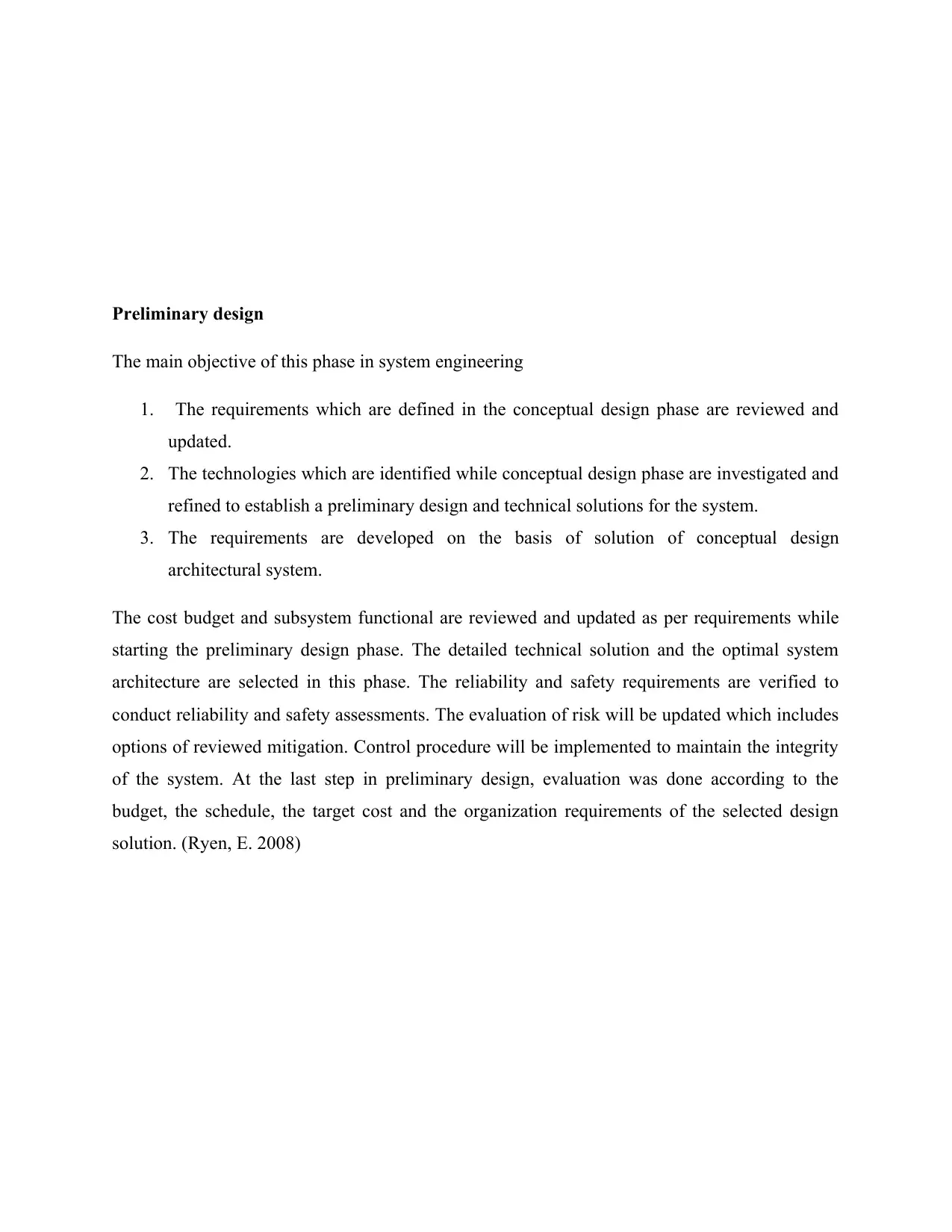
Preliminary design
The main objective of this phase in system engineering
1. The requirements which are defined in the conceptual design phase are reviewed and
updated.
2. The technologies which are identified while conceptual design phase are investigated and
refined to establish a preliminary design and technical solutions for the system.
3. The requirements are developed on the basis of solution of conceptual design
architectural system.
The cost budget and subsystem functional are reviewed and updated as per requirements while
starting the preliminary design phase. The detailed technical solution and the optimal system
architecture are selected in this phase. The reliability and safety requirements are verified to
conduct reliability and safety assessments. The evaluation of risk will be updated which includes
options of reviewed mitigation. Control procedure will be implemented to maintain the integrity
of the system. At the last step in preliminary design, evaluation was done according to the
budget, the schedule, the target cost and the organization requirements of the selected design
solution. (Ryen, E. 2008)
The main objective of this phase in system engineering
1. The requirements which are defined in the conceptual design phase are reviewed and
updated.
2. The technologies which are identified while conceptual design phase are investigated and
refined to establish a preliminary design and technical solutions for the system.
3. The requirements are developed on the basis of solution of conceptual design
architectural system.
The cost budget and subsystem functional are reviewed and updated as per requirements while
starting the preliminary design phase. The detailed technical solution and the optimal system
architecture are selected in this phase. The reliability and safety requirements are verified to
conduct reliability and safety assessments. The evaluation of risk will be updated which includes
options of reviewed mitigation. Control procedure will be implemented to maintain the integrity
of the system. At the last step in preliminary design, evaluation was done according to the
budget, the schedule, the target cost and the organization requirements of the selected design
solution. (Ryen, E. 2008)
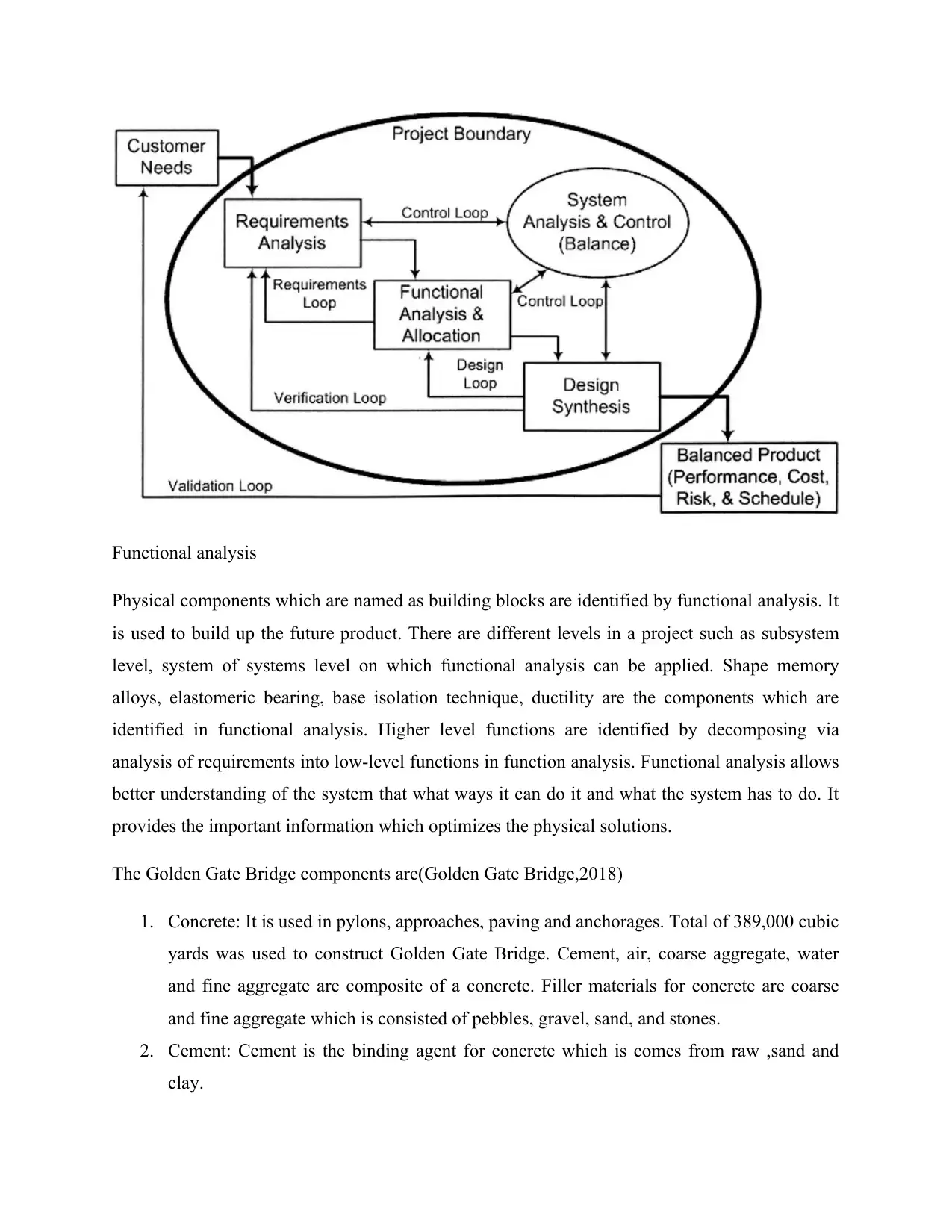
Functional analysis
Physical components which are named as building blocks are identified by functional analysis. It
is used to build up the future product. There are different levels in a project such as subsystem
level, system of systems level on which functional analysis can be applied. Shape memory
alloys, elastomeric bearing, base isolation technique, ductility are the components which are
identified in functional analysis. Higher level functions are identified by decomposing via
analysis of requirements into low-level functions in function analysis. Functional analysis allows
better understanding of the system that what ways it can do it and what the system has to do. It
provides the important information which optimizes the physical solutions.
The Golden Gate Bridge components are(Golden Gate Bridge,2018)
1. Concrete: It is used in pylons, approaches, paving and anchorages. Total of 389,000 cubic
yards was used to construct Golden Gate Bridge. Cement, air, coarse aggregate, water
and fine aggregate are composite of a concrete. Filler materials for concrete are coarse
and fine aggregate which is consisted of pebbles, gravel, sand, and stones.
2. Cement: Cement is the binding agent for concrete which is comes from raw ,sand and
clay.
Physical components which are named as building blocks are identified by functional analysis. It
is used to build up the future product. There are different levels in a project such as subsystem
level, system of systems level on which functional analysis can be applied. Shape memory
alloys, elastomeric bearing, base isolation technique, ductility are the components which are
identified in functional analysis. Higher level functions are identified by decomposing via
analysis of requirements into low-level functions in function analysis. Functional analysis allows
better understanding of the system that what ways it can do it and what the system has to do. It
provides the important information which optimizes the physical solutions.
The Golden Gate Bridge components are(Golden Gate Bridge,2018)
1. Concrete: It is used in pylons, approaches, paving and anchorages. Total of 389,000 cubic
yards was used to construct Golden Gate Bridge. Cement, air, coarse aggregate, water
and fine aggregate are composite of a concrete. Filler materials for concrete are coarse
and fine aggregate which is consisted of pebbles, gravel, sand, and stones.
2. Cement: Cement is the binding agent for concrete which is comes from raw ,sand and
clay.
⊘ This is a preview!⊘
Do you want full access?
Subscribe today to unlock all pages.

Trusted by 1+ million students worldwide
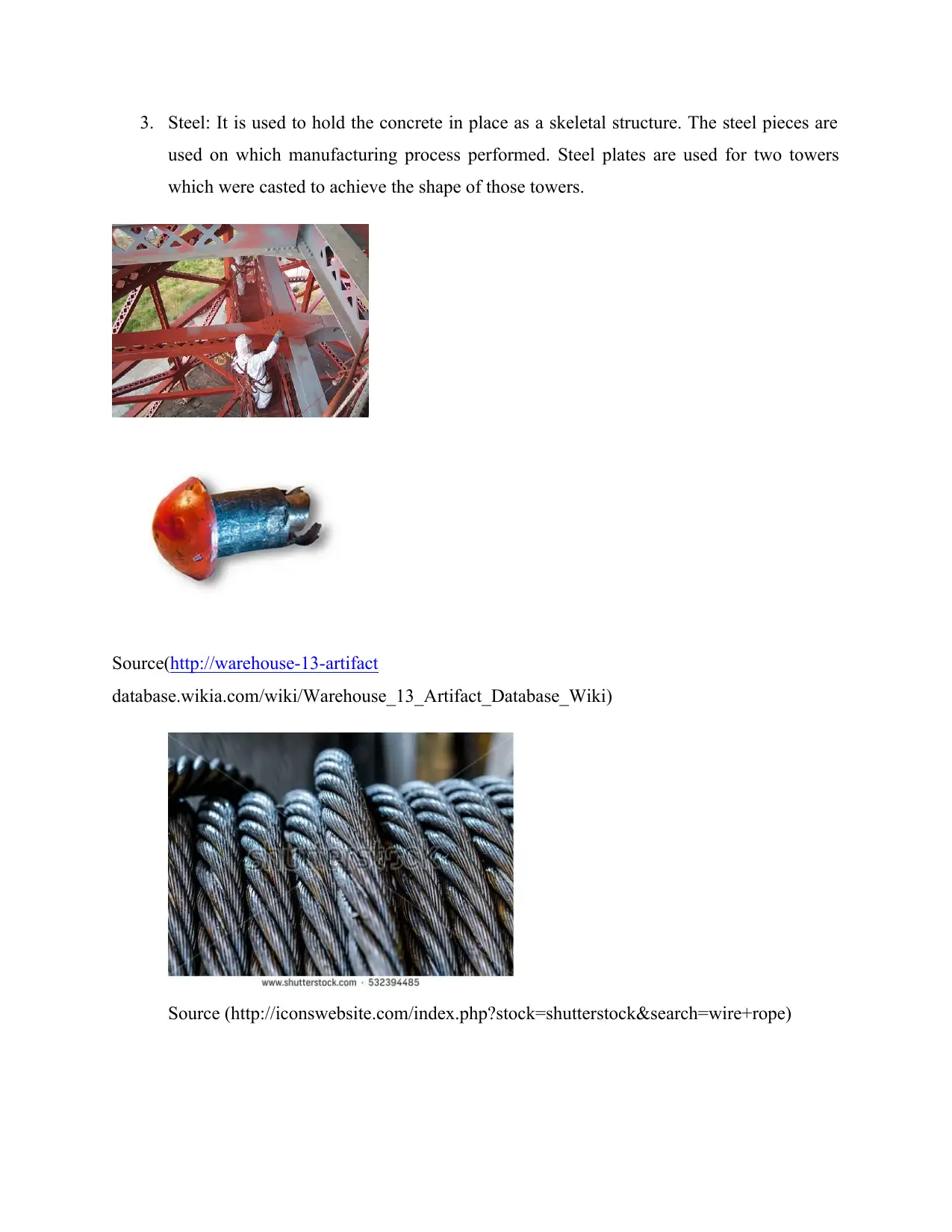
3. Steel: It is used to hold the concrete in place as a skeletal structure. The steel pieces are
used on which manufacturing process performed. Steel plates are used for two towers
which were casted to achieve the shape of those towers.
Source(http://warehouse-13-artifact
database.wikia.com/wiki/Warehouse_13_Artifact_Database_Wiki)
Source (http://iconswebsite.com/index.php?stock=shutterstock&search=wire+rope)
used on which manufacturing process performed. Steel plates are used for two towers
which were casted to achieve the shape of those towers.
Source(http://warehouse-13-artifact
database.wikia.com/wiki/Warehouse_13_Artifact_Database_Wiki)
Source (http://iconswebsite.com/index.php?stock=shutterstock&search=wire+rope)
Paraphrase This Document
Need a fresh take? Get an instant paraphrase of this document with our AI Paraphraser
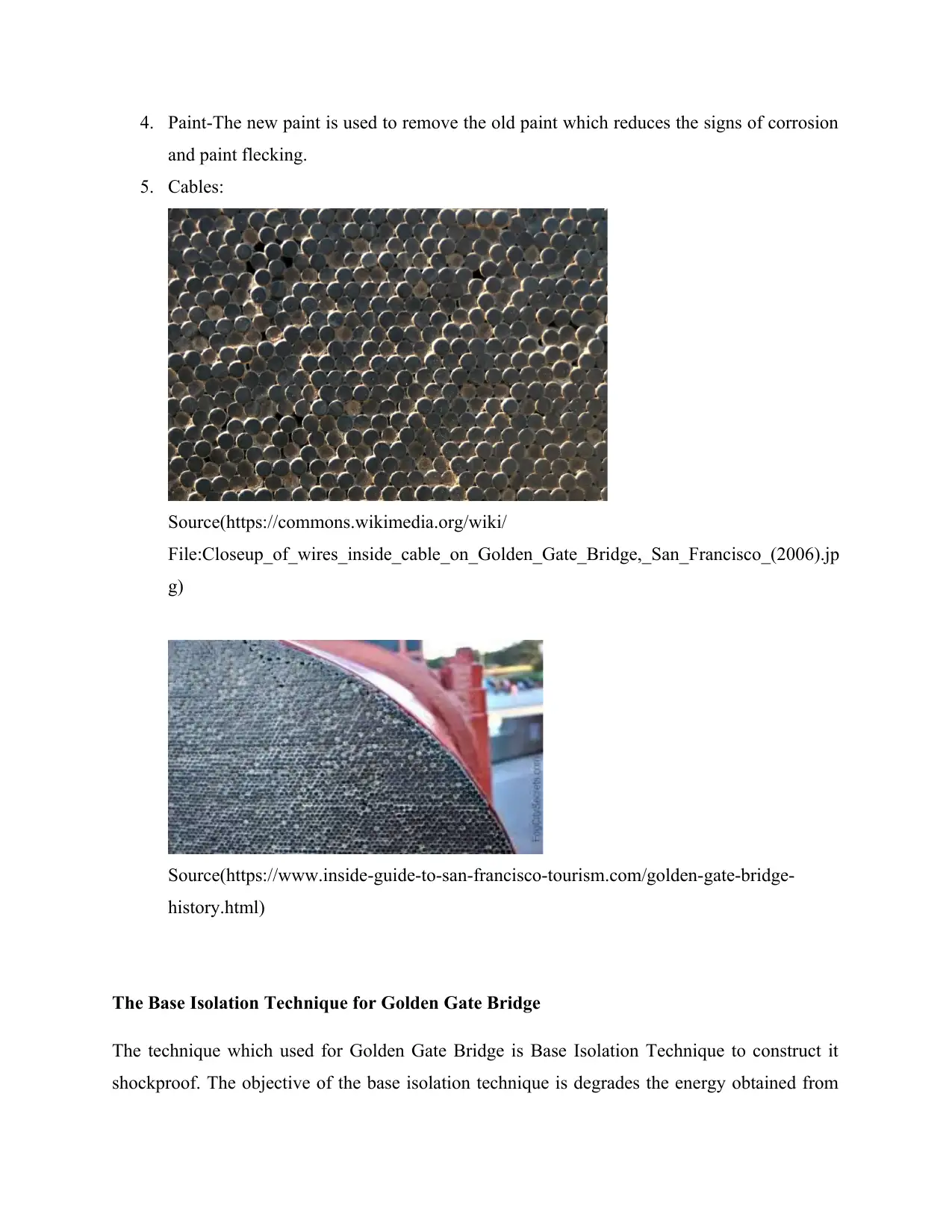
4. Paint-The new paint is used to remove the old paint which reduces the signs of corrosion
and paint flecking.
5. Cables:
Source(https://commons.wikimedia.org/wiki/
File:Closeup_of_wires_inside_cable_on_Golden_Gate_Bridge,_San_Francisco_(2006).jp
g)
Source(https://www.inside-guide-to-san-francisco-tourism.com/golden-gate-bridge-
history.html)
The Base Isolation Technique for Golden Gate Bridge
The technique which used for Golden Gate Bridge is Base Isolation Technique to construct it
shockproof. The objective of the base isolation technique is degrades the energy obtained from
and paint flecking.
5. Cables:
Source(https://commons.wikimedia.org/wiki/
File:Closeup_of_wires_inside_cable_on_Golden_Gate_Bridge,_San_Francisco_(2006).jp
g)
Source(https://www.inside-guide-to-san-francisco-tourism.com/golden-gate-bridge-
history.html)
The Base Isolation Technique for Golden Gate Bridge
The technique which used for Golden Gate Bridge is Base Isolation Technique to construct it
shockproof. The objective of the base isolation technique is degrades the energy obtained from
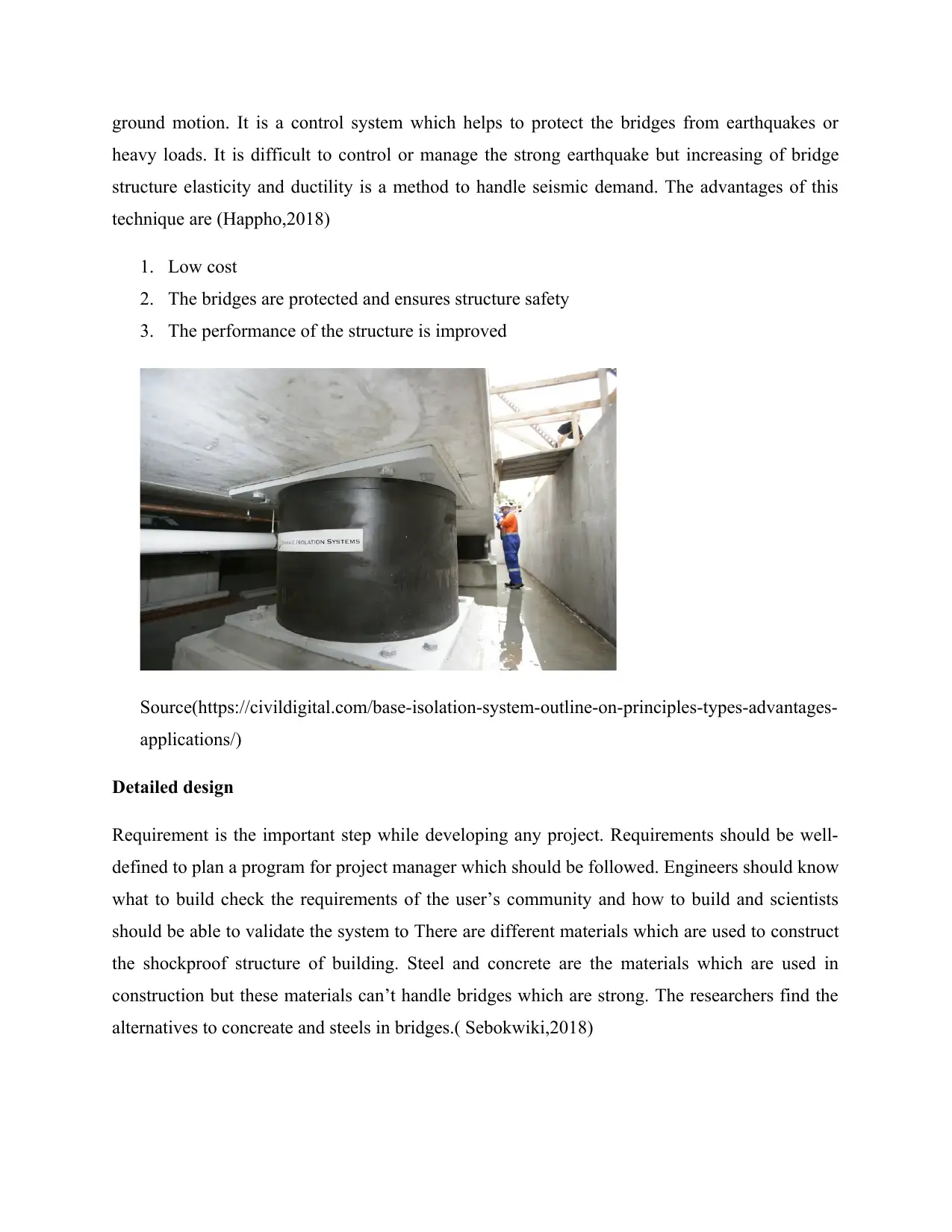
ground motion. It is a control system which helps to protect the bridges from earthquakes or
heavy loads. It is difficult to control or manage the strong earthquake but increasing of bridge
structure elasticity and ductility is a method to handle seismic demand. The advantages of this
technique are (Happho,2018)
1. Low cost
2. The bridges are protected and ensures structure safety
3. The performance of the structure is improved
Source(https://civildigital.com/base-isolation-system-outline-on-principles-types-advantages-
applications/)
Detailed design
Requirement is the important step while developing any project. Requirements should be well-
defined to plan a program for project manager which should be followed. Engineers should know
what to build check the requirements of the user’s community and how to build and scientists
should be able to validate the system to There are different materials which are used to construct
the shockproof structure of building. Steel and concrete are the materials which are used in
construction but these materials can’t handle bridges which are strong. The researchers find the
alternatives to concreate and steels in bridges.( Sebokwiki,2018)
heavy loads. It is difficult to control or manage the strong earthquake but increasing of bridge
structure elasticity and ductility is a method to handle seismic demand. The advantages of this
technique are (Happho,2018)
1. Low cost
2. The bridges are protected and ensures structure safety
3. The performance of the structure is improved
Source(https://civildigital.com/base-isolation-system-outline-on-principles-types-advantages-
applications/)
Detailed design
Requirement is the important step while developing any project. Requirements should be well-
defined to plan a program for project manager which should be followed. Engineers should know
what to build check the requirements of the user’s community and how to build and scientists
should be able to validate the system to There are different materials which are used to construct
the shockproof structure of building. Steel and concrete are the materials which are used in
construction but these materials can’t handle bridges which are strong. The researchers find the
alternatives to concreate and steels in bridges.( Sebokwiki,2018)
⊘ This is a preview!⊘
Do you want full access?
Subscribe today to unlock all pages.

Trusted by 1+ million students worldwide
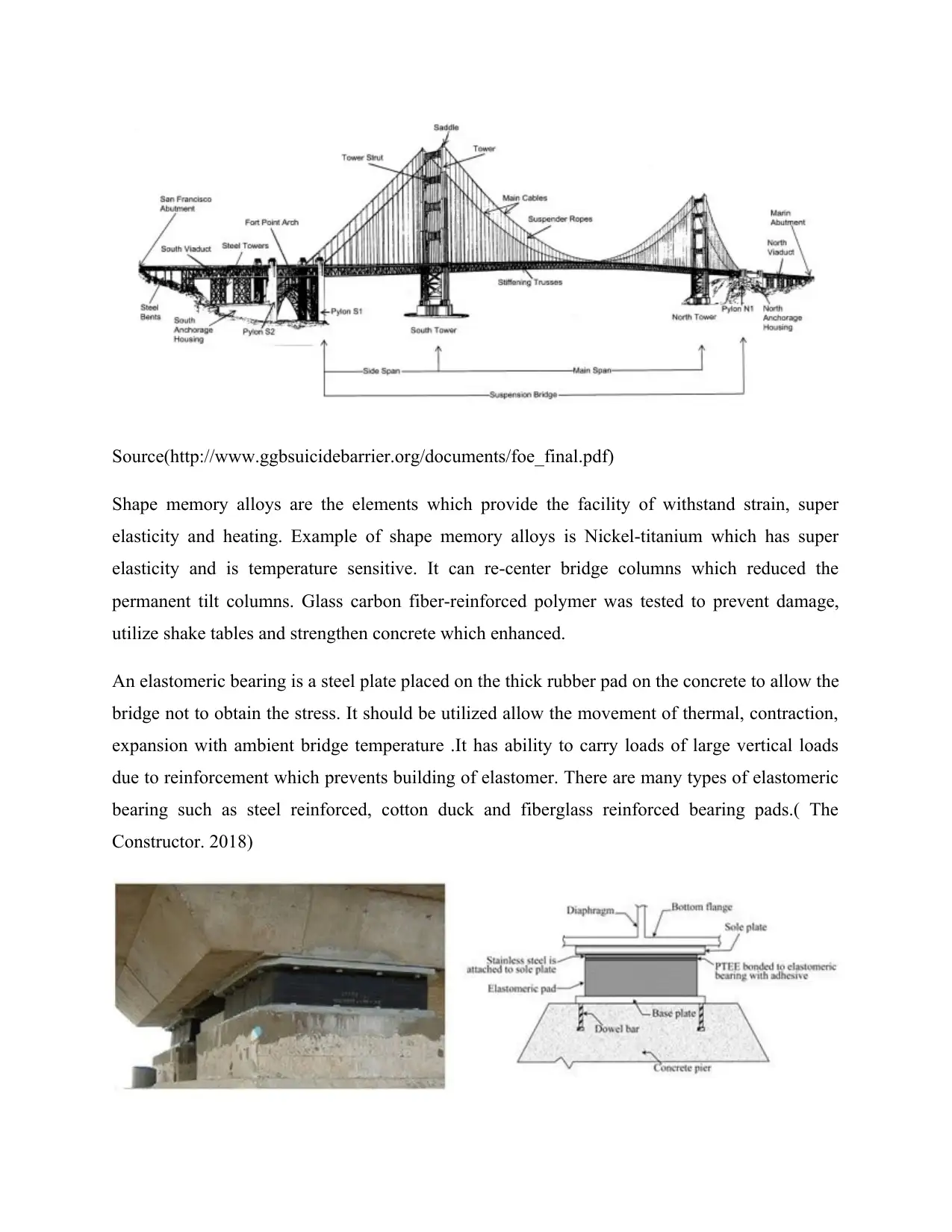
Source(http://www.ggbsuicidebarrier.org/documents/foe_final.pdf)
Shape memory alloys are the elements which provide the facility of withstand strain, super
elasticity and heating. Example of shape memory alloys is Nickel-titanium which has super
elasticity and is temperature sensitive. It can re-center bridge columns which reduced the
permanent tilt columns. Glass carbon fiber-reinforced polymer was tested to prevent damage,
utilize shake tables and strengthen concrete which enhanced.
An elastomeric bearing is a steel plate placed on the thick rubber pad on the concrete to allow the
bridge not to obtain the stress. It should be utilized allow the movement of thermal, contraction,
expansion with ambient bridge temperature .It has ability to carry loads of large vertical loads
due to reinforcement which prevents building of elastomer. There are many types of elastomeric
bearing such as steel reinforced, cotton duck and fiberglass reinforced bearing pads.( The
Constructor. 2018)
Shape memory alloys are the elements which provide the facility of withstand strain, super
elasticity and heating. Example of shape memory alloys is Nickel-titanium which has super
elasticity and is temperature sensitive. It can re-center bridge columns which reduced the
permanent tilt columns. Glass carbon fiber-reinforced polymer was tested to prevent damage,
utilize shake tables and strengthen concrete which enhanced.
An elastomeric bearing is a steel plate placed on the thick rubber pad on the concrete to allow the
bridge not to obtain the stress. It should be utilized allow the movement of thermal, contraction,
expansion with ambient bridge temperature .It has ability to carry loads of large vertical loads
due to reinforcement which prevents building of elastomer. There are many types of elastomeric
bearing such as steel reinforced, cotton duck and fiberglass reinforced bearing pads.( The
Constructor. 2018)
Paraphrase This Document
Need a fresh take? Get an instant paraphrase of this document with our AI Paraphraser
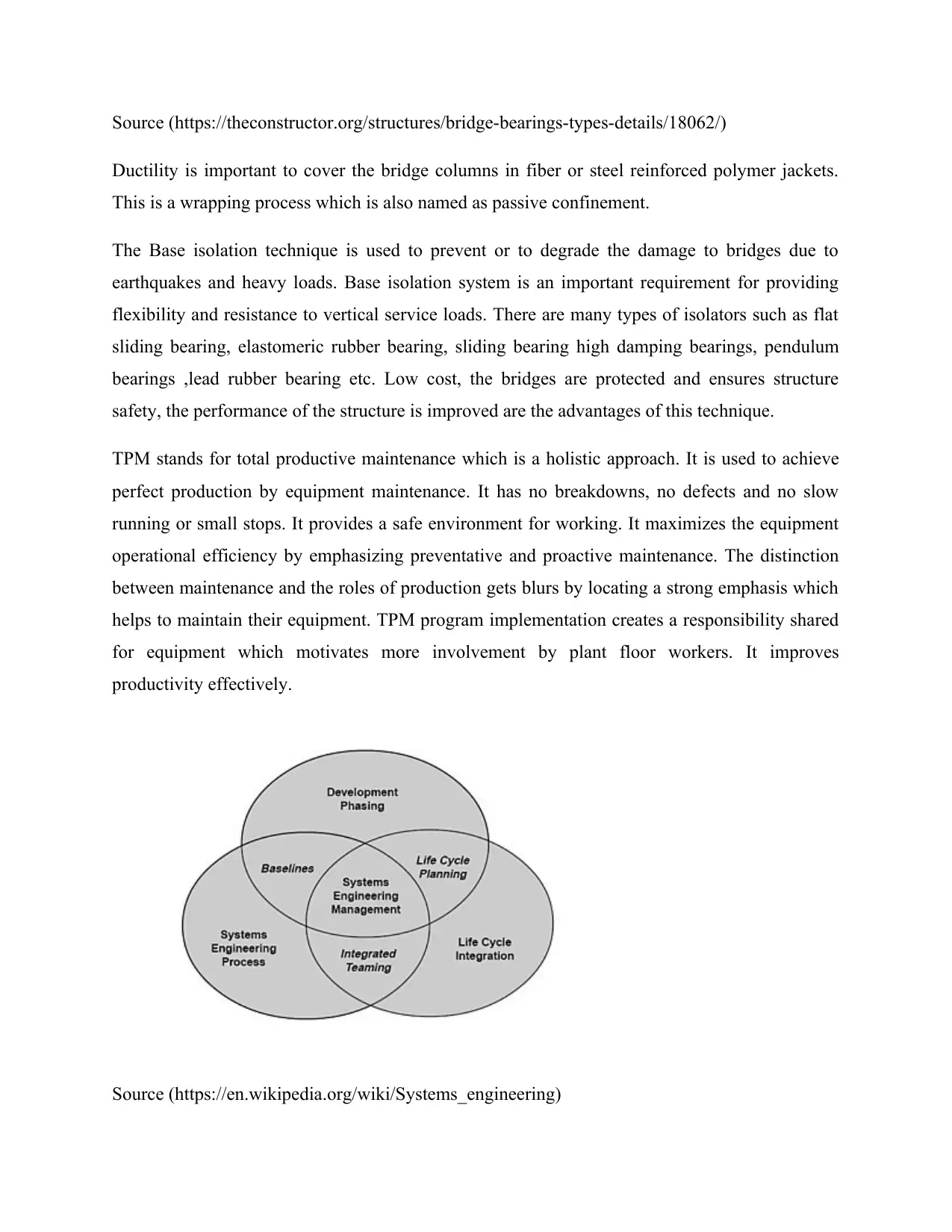
Source (https://theconstructor.org/structures/bridge-bearings-types-details/18062/)
Ductility is important to cover the bridge columns in fiber or steel reinforced polymer jackets.
This is a wrapping process which is also named as passive confinement.
The Base isolation technique is used to prevent or to degrade the damage to bridges due to
earthquakes and heavy loads. Base isolation system is an important requirement for providing
flexibility and resistance to vertical service loads. There are many types of isolators such as flat
sliding bearing, elastomeric rubber bearing, sliding bearing high damping bearings, pendulum
bearings ,lead rubber bearing etc. Low cost, the bridges are protected and ensures structure
safety, the performance of the structure is improved are the advantages of this technique.
TPM stands for total productive maintenance which is a holistic approach. It is used to achieve
perfect production by equipment maintenance. It has no breakdowns, no defects and no slow
running or small stops. It provides a safe environment for working. It maximizes the equipment
operational efficiency by emphasizing preventative and proactive maintenance. The distinction
between maintenance and the roles of production gets blurs by locating a strong emphasis which
helps to maintain their equipment. TPM program implementation creates a responsibility shared
for equipment which motivates more involvement by plant floor workers. It improves
productivity effectively.
Source (https://en.wikipedia.org/wiki/Systems_engineering)
Ductility is important to cover the bridge columns in fiber or steel reinforced polymer jackets.
This is a wrapping process which is also named as passive confinement.
The Base isolation technique is used to prevent or to degrade the damage to bridges due to
earthquakes and heavy loads. Base isolation system is an important requirement for providing
flexibility and resistance to vertical service loads. There are many types of isolators such as flat
sliding bearing, elastomeric rubber bearing, sliding bearing high damping bearings, pendulum
bearings ,lead rubber bearing etc. Low cost, the bridges are protected and ensures structure
safety, the performance of the structure is improved are the advantages of this technique.
TPM stands for total productive maintenance which is a holistic approach. It is used to achieve
perfect production by equipment maintenance. It has no breakdowns, no defects and no slow
running or small stops. It provides a safe environment for working. It maximizes the equipment
operational efficiency by emphasizing preventative and proactive maintenance. The distinction
between maintenance and the roles of production gets blurs by locating a strong emphasis which
helps to maintain their equipment. TPM program implementation creates a responsibility shared
for equipment which motivates more involvement by plant floor workers. It improves
productivity effectively.
Source (https://en.wikipedia.org/wiki/Systems_engineering)
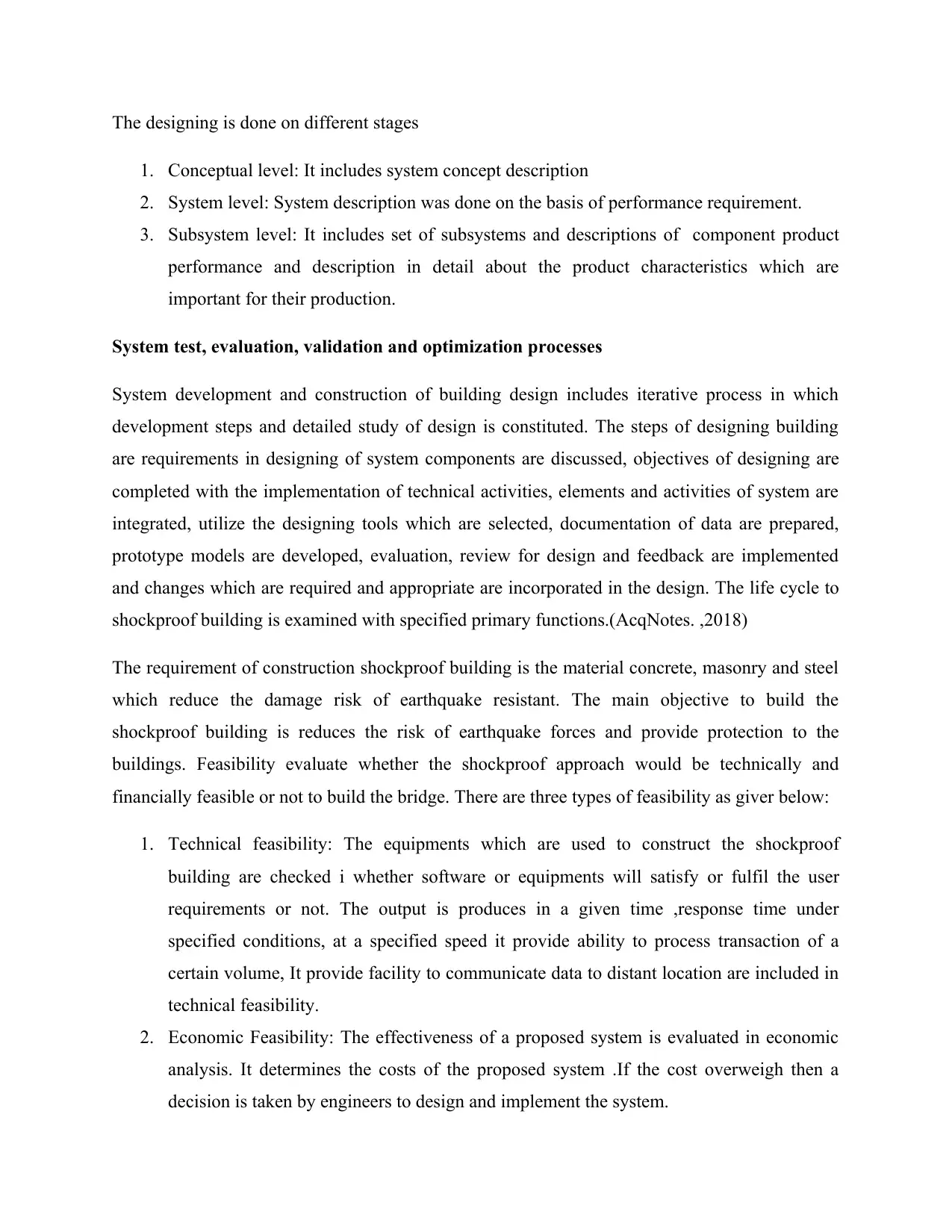
The designing is done on different stages
1. Conceptual level: It includes system concept description
2. System level: System description was done on the basis of performance requirement.
3. Subsystem level: It includes set of subsystems and descriptions of component product
performance and description in detail about the product characteristics which are
important for their production.
System test, evaluation, validation and optimization processes
System development and construction of building design includes iterative process in which
development steps and detailed study of design is constituted. The steps of designing building
are requirements in designing of system components are discussed, objectives of designing are
completed with the implementation of technical activities, elements and activities of system are
integrated, utilize the designing tools which are selected, documentation of data are prepared,
prototype models are developed, evaluation, review for design and feedback are implemented
and changes which are required and appropriate are incorporated in the design. The life cycle to
shockproof building is examined with specified primary functions.(AcqNotes. ,2018)
The requirement of construction shockproof building is the material concrete, masonry and steel
which reduce the damage risk of earthquake resistant. The main objective to build the
shockproof building is reduces the risk of earthquake forces and provide protection to the
buildings. Feasibility evaluate whether the shockproof approach would be technically and
financially feasible or not to build the bridge. There are three types of feasibility as giver below:
1. Technical feasibility: The equipments which are used to construct the shockproof
building are checked i whether software or equipments will satisfy or fulfil the user
requirements or not. The output is produces in a given time ,response time under
specified conditions, at a specified speed it provide ability to process transaction of a
certain volume, It provide facility to communicate data to distant location are included in
technical feasibility.
2. Economic Feasibility: The effectiveness of a proposed system is evaluated in economic
analysis. It determines the costs of the proposed system .If the cost overweigh then a
decision is taken by engineers to design and implement the system.
1. Conceptual level: It includes system concept description
2. System level: System description was done on the basis of performance requirement.
3. Subsystem level: It includes set of subsystems and descriptions of component product
performance and description in detail about the product characteristics which are
important for their production.
System test, evaluation, validation and optimization processes
System development and construction of building design includes iterative process in which
development steps and detailed study of design is constituted. The steps of designing building
are requirements in designing of system components are discussed, objectives of designing are
completed with the implementation of technical activities, elements and activities of system are
integrated, utilize the designing tools which are selected, documentation of data are prepared,
prototype models are developed, evaluation, review for design and feedback are implemented
and changes which are required and appropriate are incorporated in the design. The life cycle to
shockproof building is examined with specified primary functions.(AcqNotes. ,2018)
The requirement of construction shockproof building is the material concrete, masonry and steel
which reduce the damage risk of earthquake resistant. The main objective to build the
shockproof building is reduces the risk of earthquake forces and provide protection to the
buildings. Feasibility evaluate whether the shockproof approach would be technically and
financially feasible or not to build the bridge. There are three types of feasibility as giver below:
1. Technical feasibility: The equipments which are used to construct the shockproof
building are checked i whether software or equipments will satisfy or fulfil the user
requirements or not. The output is produces in a given time ,response time under
specified conditions, at a specified speed it provide ability to process transaction of a
certain volume, It provide facility to communicate data to distant location are included in
technical feasibility.
2. Economic Feasibility: The effectiveness of a proposed system is evaluated in economic
analysis. It determines the costs of the proposed system .If the cost overweigh then a
decision is taken by engineers to design and implement the system.
⊘ This is a preview!⊘
Do you want full access?
Subscribe today to unlock all pages.

Trusted by 1+ million students worldwide
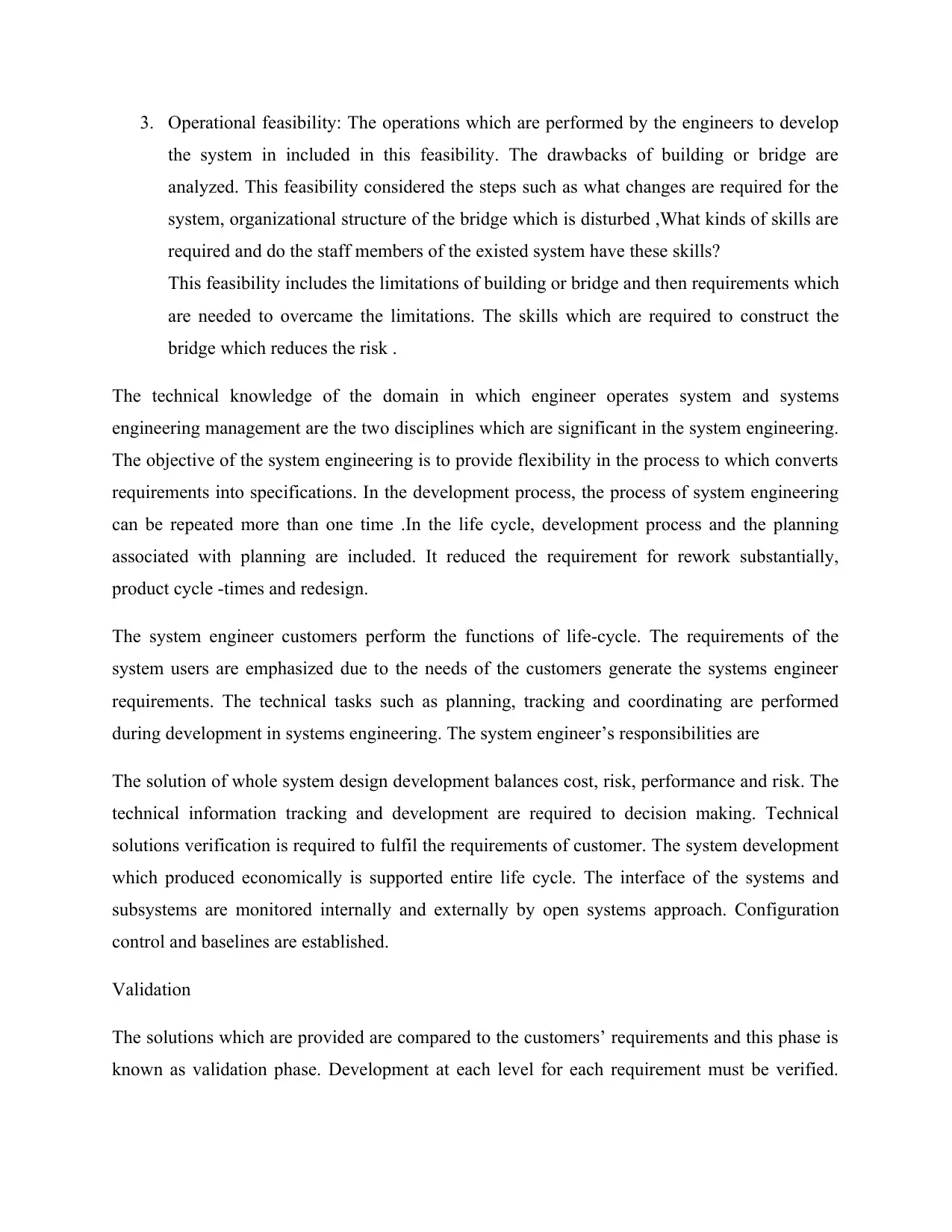
3. Operational feasibility: The operations which are performed by the engineers to develop
the system in included in this feasibility. The drawbacks of building or bridge are
analyzed. This feasibility considered the steps such as what changes are required for the
system, organizational structure of the bridge which is disturbed ,What kinds of skills are
required and do the staff members of the existed system have these skills?
This feasibility includes the limitations of building or bridge and then requirements which
are needed to overcame the limitations. The skills which are required to construct the
bridge which reduces the risk .
The technical knowledge of the domain in which engineer operates system and systems
engineering management are the two disciplines which are significant in the system engineering.
The objective of the system engineering is to provide flexibility in the process to which converts
requirements into specifications. In the development process, the process of system engineering
can be repeated more than one time .In the life cycle, development process and the planning
associated with planning are included. It reduced the requirement for rework substantially,
product cycle -times and redesign.
The system engineer customers perform the functions of life-cycle. The requirements of the
system users are emphasized due to the needs of the customers generate the systems engineer
requirements. The technical tasks such as planning, tracking and coordinating are performed
during development in systems engineering. The system engineer’s responsibilities are
The solution of whole system design development balances cost, risk, performance and risk. The
technical information tracking and development are required to decision making. Technical
solutions verification is required to fulfil the requirements of customer. The system development
which produced economically is supported entire life cycle. The interface of the systems and
subsystems are monitored internally and externally by open systems approach. Configuration
control and baselines are established.
Validation
The solutions which are provided are compared to the customers’ requirements and this phase is
known as validation phase. Development at each level for each requirement must be verified.
the system in included in this feasibility. The drawbacks of building or bridge are
analyzed. This feasibility considered the steps such as what changes are required for the
system, organizational structure of the bridge which is disturbed ,What kinds of skills are
required and do the staff members of the existed system have these skills?
This feasibility includes the limitations of building or bridge and then requirements which
are needed to overcame the limitations. The skills which are required to construct the
bridge which reduces the risk .
The technical knowledge of the domain in which engineer operates system and systems
engineering management are the two disciplines which are significant in the system engineering.
The objective of the system engineering is to provide flexibility in the process to which converts
requirements into specifications. In the development process, the process of system engineering
can be repeated more than one time .In the life cycle, development process and the planning
associated with planning are included. It reduced the requirement for rework substantially,
product cycle -times and redesign.
The system engineer customers perform the functions of life-cycle. The requirements of the
system users are emphasized due to the needs of the customers generate the systems engineer
requirements. The technical tasks such as planning, tracking and coordinating are performed
during development in systems engineering. The system engineer’s responsibilities are
The solution of whole system design development balances cost, risk, performance and risk. The
technical information tracking and development are required to decision making. Technical
solutions verification is required to fulfil the requirements of customer. The system development
which produced economically is supported entire life cycle. The interface of the systems and
subsystems are monitored internally and externally by open systems approach. Configuration
control and baselines are established.
Validation
The solutions which are provided are compared to the customers’ requirements and this phase is
known as validation phase. Development at each level for each requirement must be verified.
Paraphrase This Document
Need a fresh take? Get an instant paraphrase of this document with our AI Paraphraser
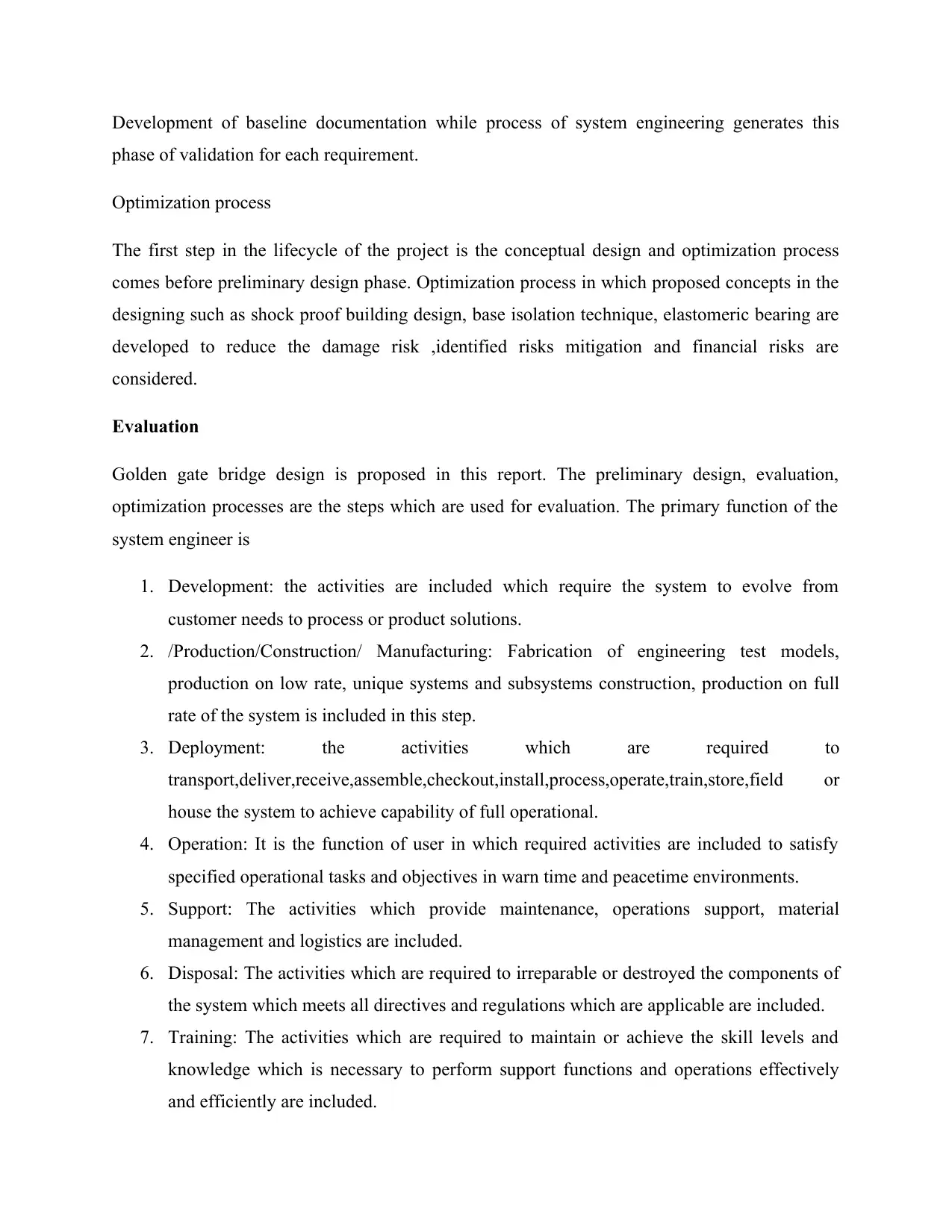
Development of baseline documentation while process of system engineering generates this
phase of validation for each requirement.
Optimization process
The first step in the lifecycle of the project is the conceptual design and optimization process
comes before preliminary design phase. Optimization process in which proposed concepts in the
designing such as shock proof building design, base isolation technique, elastomeric bearing are
developed to reduce the damage risk ,identified risks mitigation and financial risks are
considered.
Evaluation
Golden gate bridge design is proposed in this report. The preliminary design, evaluation,
optimization processes are the steps which are used for evaluation. The primary function of the
system engineer is
1. Development: the activities are included which require the system to evolve from
customer needs to process or product solutions.
2. /Production/Construction/ Manufacturing: Fabrication of engineering test models,
production on low rate, unique systems and subsystems construction, production on full
rate of the system is included in this step.
3. Deployment: the activities which are required to
transport,deliver,receive,assemble,checkout,install,process,operate,train,store,field or
house the system to achieve capability of full operational.
4. Operation: It is the function of user in which required activities are included to satisfy
specified operational tasks and objectives in warn time and peacetime environments.
5. Support: The activities which provide maintenance, operations support, material
management and logistics are included.
6. Disposal: The activities which are required to irreparable or destroyed the components of
the system which meets all directives and regulations which are applicable are included.
7. Training: The activities which are required to maintain or achieve the skill levels and
knowledge which is necessary to perform support functions and operations effectively
and efficiently are included.
phase of validation for each requirement.
Optimization process
The first step in the lifecycle of the project is the conceptual design and optimization process
comes before preliminary design phase. Optimization process in which proposed concepts in the
designing such as shock proof building design, base isolation technique, elastomeric bearing are
developed to reduce the damage risk ,identified risks mitigation and financial risks are
considered.
Evaluation
Golden gate bridge design is proposed in this report. The preliminary design, evaluation,
optimization processes are the steps which are used for evaluation. The primary function of the
system engineer is
1. Development: the activities are included which require the system to evolve from
customer needs to process or product solutions.
2. /Production/Construction/ Manufacturing: Fabrication of engineering test models,
production on low rate, unique systems and subsystems construction, production on full
rate of the system is included in this step.
3. Deployment: the activities which are required to
transport,deliver,receive,assemble,checkout,install,process,operate,train,store,field or
house the system to achieve capability of full operational.
4. Operation: It is the function of user in which required activities are included to satisfy
specified operational tasks and objectives in warn time and peacetime environments.
5. Support: The activities which provide maintenance, operations support, material
management and logistics are included.
6. Disposal: The activities which are required to irreparable or destroyed the components of
the system which meets all directives and regulations which are applicable are included.
7. Training: The activities which are required to maintain or achieve the skill levels and
knowledge which is necessary to perform support functions and operations effectively
and efficiently are included.
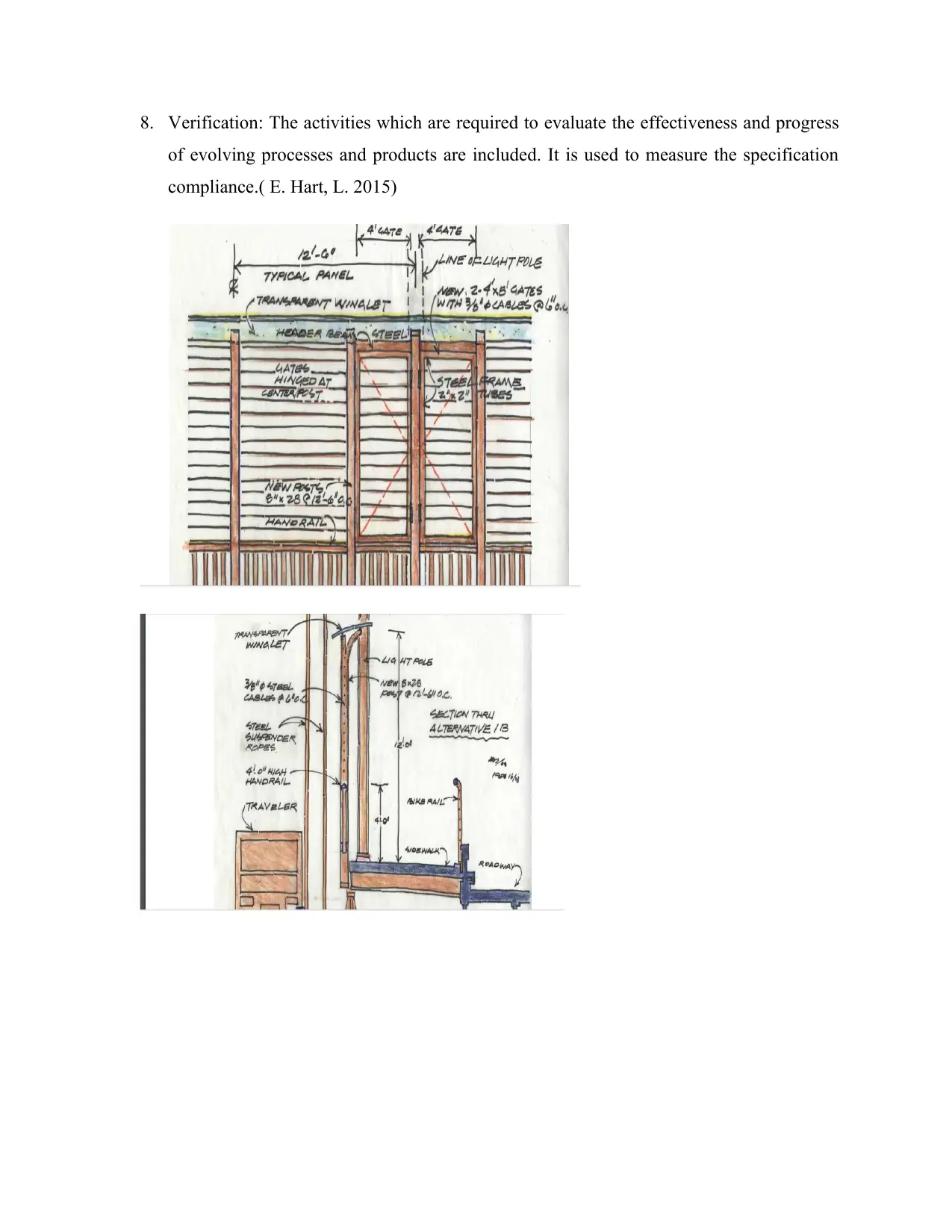
8. Verification: The activities which are required to evaluate the effectiveness and progress
of evolving processes and products are included. It is used to measure the specification
compliance.( E. Hart, L. 2015)
of evolving processes and products are included. It is used to measure the specification
compliance.( E. Hart, L. 2015)
⊘ This is a preview!⊘
Do you want full access?
Subscribe today to unlock all pages.

Trusted by 1+ million students worldwide
1 out of 15
Your All-in-One AI-Powered Toolkit for Academic Success.
+13062052269
info@desklib.com
Available 24*7 on WhatsApp / Email
![[object Object]](/_next/static/media/star-bottom.7253800d.svg)
Unlock your academic potential
Copyright © 2020–2025 A2Z Services. All Rights Reserved. Developed and managed by ZUCOL.

